Short notes from the final crit before christmas.
Sharon
Had tutorial with JR+JL
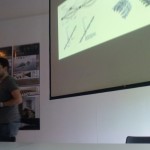
Andreas
Digital presentation. Arrived on time. Working on TelAviv site. Showing climate data. Wind direction + power.
What is the relationship between the structure and the subject (of algae collection). What does the waves do to the structure and function. Representations are pretty unclear. Why hte specifically knitted material. What is the relation between the exact knit and the algae. Is knit needed, can you not simply pierce the plastic. Does component system which is meant to filter water really work on land? What kind of environment does the system create out of the water. Lack of context; how does the algae perform in relation to climate, how does it get into the processing plant, how much do you need to produce at different times. Production of bio fuel, what are the facilities needed, can it be a shed? The architectural potential has not been very fully explored.
– More exhaustive testing of physical models.
– More research on the algae production.
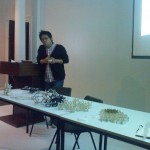
Haen-Suk
Very late.
Renderings of control systems of parts, but no tests in physical models. Must look at control principle, the design of movement/transformation and architectural qualities such as skin etc. Must work more iteratively with physical/digital models.
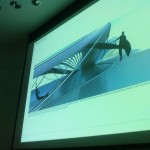
Michal
Very late.
Site as before, mentioning weaving and using the BMW car references. Images of rendered models with fabrics etc, and three small study models.
Many more large models. Maybe work with more solid parts in combination with fabrics. Maybe working in different scales across the surface.
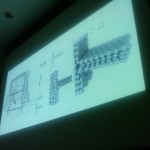
Chi Sung
Very late.
Some new material. Applying the system to very conventional building system. Structural or ornament? More studies on spatial performance, scale and different applications. Current applications are not convincing at all. Must define and find fruitful performance of the system. Interesting to see how it can work as many different things, but not many things at the same time. Folded material should work as reinforcement.
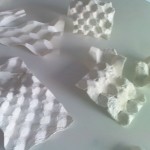
Sakiko
Exhaustive presentation of folded system. Toyo Ito reference. Using the surface as a mold for concrete structure. Model shots are showing scale of one part of the folded structure ca 50 cm. Formwork structure to be taken away. Maintaining openings and apertures if casting with concrete.
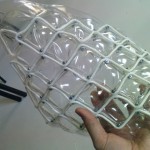
Michael
Presenting digitally only, from Indesign, giving bad image quality. Reference to Avalon shell. Inflating structure, weave around with hardening structure, remove cast. Bringing in issues from Tel Aviv. Water shortage issues, recycling etc. Now looking for a more variations and differentiations in geometry. Both air and water inflated structures. Evaporation/condensation principles.
A bit too many different approaches at this point. Some are dropped though. How is movement of water induced? How is the water getting into the system? Looked at inflatable formworks? Needs to do models that explore things not represents previous ideas.
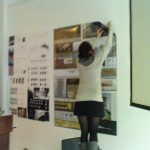
Claudia
Adaptable architectural systems for the ocean.
Manipulating water flows. Ystad. Coastal erosion. Radiolarynx. Tests with hydrogel in bags, the material does not dehydrate itself, but needs 2ndary mechanisms on order to deflate. Pure technological and machine aesthetic approach, very little spatial development. A few underwater connection tunnels are being looked at, quite arbitrary in form, using lost foam casting. 2ndary use is for de-salinization and growing on the platforms floating. Primary monitoring the coastline.
Use same structure for water control as well as spatial access? Very expensive initiative and perhaps too little effect; compared to oyster farms etc. Wants to look at manufacturing to find out how feasible the project is. Can there be more substantial structures on top if the floating structures? What kind of cultures can develop here? Conical configuration to make more above water structures. Good at constructing the narrative, but the design development must be found.
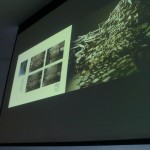
Arya
Istanbul, site conditions of interest temperature and wind. Hybrid concrete construction. Looking for joint-less structures, in contemporary bikes etc (in which the joint is material, doesn´t look like a joint, but operates as one). Mediation between light and darkness. Two material systems, auxetic structure + surface based system?
How does wind interact? How does the system connect to other spatial systems? What materials are being used, and how are they fabricated? The joints are crucial. Current status of the projects great because it´s versatile. Among all different studies, which is the best one, or favourite one? What is the transition between the skin and structural elements? How does the mediation of people´s behaviour work, especially in relation to the material behaviour? Discuss qualities, but do not make new decisions or additional design influenced by this.
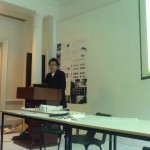
Jung Joon
Biomimetics, porosity. Several references. Brick system, with negative / positive forms. GC-based, using attractors, to control apertures and directions. Looking for light weight load bearing structure. Cnc-milled mold with several components, and fibre glass cast onto it. Massing model/surface model of double triangles.
Lacking parts of development between the material restrictions of system and massing studies (the two tracks do not relate properly). Time to go back and fill in the gaps. Panels or monocoque structures? What are the relations between the component performance (variations in spatial effects) and the wanted spatial conditions). Strange relation between milled formwork and cast panels.
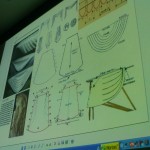
Maryam
Material origin in plastics. Catanery curves. Pleats in textiles and fabrics, threads soaked in resin etc. Gravity diagrams in colour as spatial inspiration. Form finding models in the freezer. Looked at fabrication in boat making (injection moulding). Based in physical modelling.
What are the spatial drivers? Are the physical models tests of forms, or of systems? Are they mimicking the behaviour of the final building, or searching for formal principles? More control is needed. The structure of the armature is very important. There is a need to add thickness, tectonics, and also position the work in the context of gaudi, spuybroek etc. The models are semiotic in the sense that they explore gravity, and explain gravity in certain positions or configurations. Models originated in fabrication studies, and moved on to catenery models. Can they now co-exist?
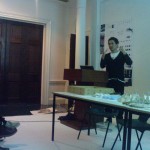
Kwan Joo
Found a similar system called hyper prefabrication system. But considers his system unique still.
Components have been the same in all parts, how can they be adopted to different things. The edges are important. What process is employed when system is used, off-site to on-site. Different to see the continuous line of interest in the exploration. Tests are stopped too early.
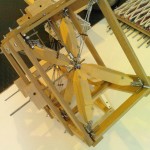
Kengo
1:5 scale model in production, also testing fabrication principles. Specific site in Israel chosen.
Why steel over fibre? Depends also on scale of structure? Steel version is slightly contained in its possibility? May use producers as technical studies. Should continue the fabrication tests, but also develop a design model at different scale, which must be informed with other conditions than the materials, i.e site, program and organizational agendas.
Kyo Dong
Not presenting
Leave a Reply